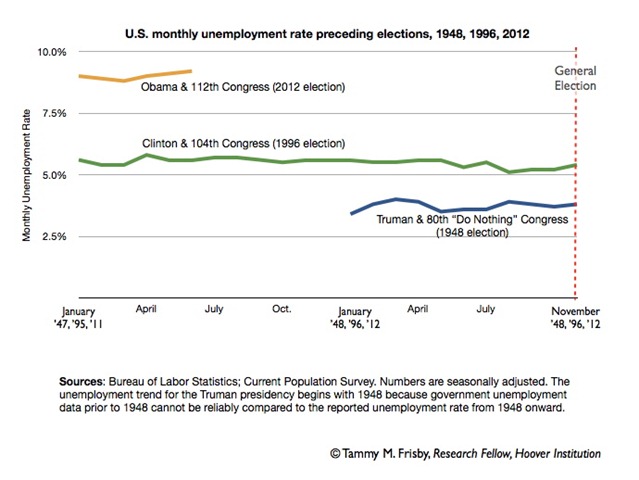- Politics, Institutions, and Public Opinion
Since the 2010 midterm elections, the conventional wisdom about Barack Obama’s reelection strategy is that he will follow the lead of other Democratic presidents who, beleaguered by governing with Republican congressional majorities, ran against Republicans in Congress as much as against the Republican nominee for president, and won a second term. The cases in point: an embattled Harry Truman ran against a “Do Nothing” Congress in 1948 and pulled off what is arguably the greatest election upset in American history. Bill Clinton, who had to assert that he was still relevant after the 1994 Republican takeover of Congress, waged a reelection campaign in 1996 that was directed as much at Newt Gingrich and his Contract with America Republicans as at Bob Dole. Truman and Clinton succeed in convincing voters (or at least they avoided getting in the way of voters figuring out for themselves) that they wanted to return the president to the White House and send along fewer Republicans and more Democrats to the House and Senate while they were at it.
Now, with the drama of the debt ceiling battle to weave into the narrative, making this the core of the Obama campaign has even greater lure.
It might work for Obama to follow the lead of Truman and Clinton and run against the Republicans in Congress. But the same campaign messaging that worked for Truman and Clinton can’t work for Obama unless the economy improves substantially.
When Truman and Clinton executed this campaign strategy, their reelection prospects were buoyed by strong economic performance in the year leading up to the election. While 1946 and 1947 saw a relatively severe recession, during the first three quarters of 1948, real GDP grew by 6.5%, 7.5%, and 2.2% (seasonally adjusted at annual rates; see the National Income and Product Accounts Table 1.1.1 from the Bureau of Economic Analysis). Although the U.S. economy was sliding into a short recession at the end of 1948, with 4th Quarter GDP growth of 0.6% and negative growth in the first two quarters of 1949, during the campaign, Truman could point to recent robust economic growth. Clinton, too, could shake hands on the receiving lines knowing that most Americans were better off than they were four years ago. Throughout 1996 the economy grew by 2.8% (Q1), 7.1% (Q2), 3.5% (Q3), and 4.4% (Q4).
Truman and Clinton could look at the nation and say, “The economy is okay (even good). I have a plan and it’s working. And, hey, have I mentioned that it would be working even better if you’d help me get rid of these clowns over in Congress who are dragging me down?”
Unless the economy experiences a dramatic turnaround over the next fifteen months, Obama can’t make the same argument to the country. The U.S. economy grew by only 0.4% and 1.3% in the first two quarters of 2011, respectively.
And then there’s the president’s jobs problem.
The graph below shows the U.S. monthly unemployment rate preceding the elections of 1948 (Truman’s reelection), 1996 (Clinton’s reelection), and 2012. The November of the General election appears at the far right hand side of the graph. The trend lines present the unemployment rate in the months leading up to the election. The trend line associated with Truman’s first term begins in 1948 instead of earlier because government unemployment data prior to 1948 cannot be reliably compared to the reported unemployment rate from 1948 onward. I show unemployment data associated with Clinton’s first term back to January 1995 so we can make a comparison with unemployment during the Obama administration.
Click on the graph to enlarge.
If there is talk about “bending the curve” going on around the West Wing these days, the president and his advisors should be talking about reducing the unemployment rate. Unemployment during the last year of Truman’s first term was relatively steady and below 4%. Unemployment hugged 5% during the second half of Clinton’s first term. Not only is unemployment much higher as Obama begins his reelection campaign in earnest, but it is ticking upward.
Unlike Truman and Clinton, Obama must convince the American people, or at least independents and other swing voters, that he does have a bankable plan for economic growth and job creation. Entrust him with another term in the White House, accompanied with more Democrats in Congress, and he’ll make it happen. That will be the message.
That he wasn’t able to prove that he could deliver on the economy when he had a huge Democratic majority in the House and a filibuster-proof Democratic majority in the Senate will not help him make his case. Whether he inherited the faltering economy of 2009 and 2010 will be beside the point to most voters in 2012.
Today, minutes after the debt limit deal passed in the Senate, Sen. Charles Schumer (D-NY) told reporters, “It is now time for Congress to get back to our regularly scheduled program, and that means jobs,” and, moreover, he said, for Democrats, job creation is their “strong suit.”
The president should hope Sen. Schumer is right.







